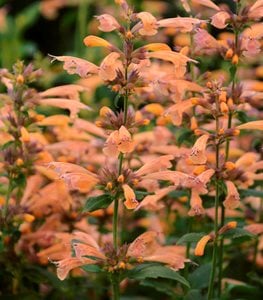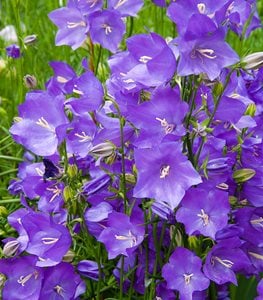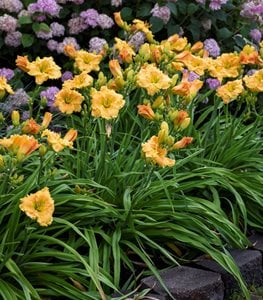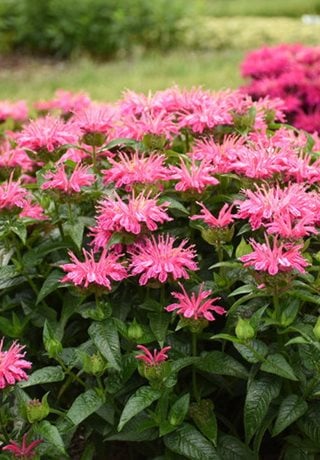20 Full-Sun Perennials That Bloom All Summer
Brighten up your landscape with these sun-loving perennial plantsThere’s a nearly endless array of plants that thrive in full sun, adding color to beds, borders, and containers. Perennials come back from year to year, providing enduring structure, long-lasting flowers and attractive foliage.
“Full sun” for plants is regarded as being at least 6 hours of direct sun per day. Some will perform even better with more sun, while others may benefit with protection from hot afternoon sun. Here are some of the best sun-loving perennials to grow, chosen for their reliability, ease of growing, long bloom time, and ornamental attributes.
BEST PERENNIALS FOR FULL SUN
AGASTACHE (Agastache spp.)
Zones: 3-10
Bloom time: Summer to fall
Habit: Upright spreading habit
Height/Spread: 1 to 6 feet tall, 1 to 3 feet wide
Also known as hummingbird mint or giant hyssop, this mint relative has pleasingly aromatic foliage. Long-lasting spiky or tubular flowers in an array of colors and shapes are especially attractive to hummingbirds, butterflies, and other insect pollinators. This North American native is exceptionally drought tolerant, deer- and rabbit-resistant.
Read more about growing agastache.
'Mango Tango' agastache from Proven Winners, pictured.
BEE BALM (Monarda spp.)
Zones: 3-9
Bloom time: Late spring to early fall
Habit: Upright spreading habit
Height/Spread: 10 inches to 4 feet tall, 8 inches to 3 feet wide
Bee balm is related to mint, with pungently scented foliage reminiscent of sage. Clusters of tubular flowers occur in shades of lavender, pink, purple, red, or white. Native to North America, the flowers are attractive to hummingbirds, butterflies, and other insect pollinators.
Read more about growing bee balm.
'Leading Lady Pink' bee balm from Proven Winners, pictured.
BELLFLOWER (Campanula spp.)
Zones: 3-9
Bloom time: Late spring to fall
Habit: Upright, mounding, or creeping habit
Height/Spread: 4 t 48 inches tall, 6 to 48 inches wide
Bellflower has long been a staple of cottage-style gardens, with white, pink, purple, or blue flowers that are cup- or bell-shaped. Serrated heart-shaped or pointed foliage is green or gold. Forms include stately upright types, mounding varieties, and creeping groundcovers.
Read more about growing bellflower.
BLACK-EYED SUSAN (Rudbeckia spp.)
Zones: 3-9, depending on the variety
Bloom time: Summer to fall
Habit: Upright spreading habit
Height/Spread: 1 to 9 feet tall, 1 to 5 feet wide
This biennial or short-lived perennial is native to North America. Cheerful daisy-like gold, bronze, red, orange, brown, or yellow flowers are a source of nectar for bees and butterflies, while seedheads provide food for songbirds during fall and winter.
Read more about growing black-eyed Susan plants.
BLAZING STAR (Liatris spp.)
Zones: 3-9
Bloom time: Summer to fall
Habit: Upright habit
Height/Spread: 1 to 5 feet tall, 6 inches to 2 feet wide
This North American prairie native is also known as gayfeather for the feathery flower plumes reminiscent of bottle brushes. Purple or white spiky flowers that bloom throughout the summer attract bees, butterflies, and other insect pollinators. Blazing star is tolerant of drought and poor soils, though good drainage is essential.
Read more about growing blazing star.
'Kobold' blazing star from Proven Winners, pictured.
CANNA (Canna spp.)
Zones: 7-11
Bloom time: Mid-summer to fall
Habit: Upright spreading habit
Height/Spread: 1-1/2 to 8 feet tall, 1-1/2 to 6 feet wide
Canna, a rhizomatous perennial related to bananas and flowering ginger, is grown for the bold foliage that lends a tropical feel to the landscape. Leaves can occur in striking patterns and colors, while flowers come in bright hues of red, orange, yellow, or white. Grow this heat lover in combination with warm-season annuals, in containers or mixed borders.
Read more about growing cannas.
Toucan® Yellow from Proven Winners, pictured.
CATMINT (Nepeta spp.)
Zones: 3-9
Bloom time: Late spring to fall
Habit: Mounding spreading habit
Height/Spread: 1 to 4 feet tall, 1 to 3 feet wide
This long-lived perennial blooms continuously from late spring until early fall, providing a consistent nectar source for hummingbirds, bees, and other insect pollinators. Small tubular flowers grow along the entire length of the stem in colors of blue, purple, lavender, pink, yellow, or white. This mint relative with aromatic foliage is exceptionally hardy, tolerates a wide range of growing conditions, and is virtually carefree.
Read more about growing catmint.
'Cat's Pajamas' catmint from Proven Winners, pictured.
CONEFLOWER (Echinacea spp.)
Zones: 3-9
Bloom time: Summer
Habit: Upright spreading habit
Height/Spread: 1 to 5 feet tall, 1 to 2 feet wide
This North American prairie native is an important source of nectar for insect pollinators, with seedheads that provide food for songbirds through fall and winter. Recent breeding breakthroughs have resulted in a wider range of flower colors and plant sizes. The cone-shaped blooms come in pink, white, yellow, green, red, and sunset hues.
Read more about how to grow coneflower plants.
Summersong™ Firefinch™ coneflower from Proven Winners, pictured.
COREOPSIS (Coreopsis spp.)
Zones: 3-9, depending on variety
Bloom time: Late spring to fall, depending on variety
Habit: Compact mounding habit
Height/Spread: 1 to 4 feet tall, 1 to 3 feet wide, depending on variety
Also known as tickseed, this North American native occurs in perennial and annual forms. Single or double daisy-like flowers in a range of colors attract butterflies and other insect pollinators, while seedheads provide food for songbirds through fall and winter. These tough plants are tolerant of drought and poor soils providing there is adequate drainage.
Read more about how to grow tickseed plants.
DAYLILY (Hemerocallis spp.)
Zones: 3-9
Bloom time: Late spring to fall, depending on variety
Habit: Upright spreading habit
Height/Spread: 1 to 6 feet tall, 1 to 4 feet wide
One of the most popular summer-flowering perennials, there are thousands of different daylily varieties in an endless array of flower colors and shapes. Individual flowers bloom for a single day, with some varieties having the ability to repeat bloom later in the season. This reliable perennial is exceptionally hardy, low maintenance, and long-lived.
Read more about growing daylilies.
Rainbow Rhythm® 'Orange Smoothie' daylily from Proven Winners, pictured.
DIANTHUS (Dianthus spp.)
Zones: 3-9, depending on the variety
Bloom time: Spring to early summer, with some reblooming until fall
Habit: Upright, mounding, or spreading habit
Height/Spread: 4 to 36 inches tall, 4 to 24 inches wide
This diverse genus comprises hundreds of perennial, annual, and biennial varieties, from compact groundcovers to upright stately forms. Strappy grass-like foliage is complemented by frilly flowers in nearly every color imaginable. Dianthus has long been a cottage garden favorite for its sweet clove-like scent and charming long-lived blooms that make excellent cut flowers.
Read more about growing dianthus plants.
Fruit Punch® 'Sweetie Pie' dianthus from Proven Winners, pictured.
LAMB'S EAR (Stachys byzantina)
Zones: 4-9
Bloom time: Late spring to early summer
Habit: Mounding spreading habit
Height/Spread: 6 to 8 inches tall, 1 to 2 feet wide, with flower spikes reaching 12 to 18 inches tall
This evergreen mat-forming perennial is named for the velvety silver leaves that resemble lamb’s ears. Silver spikes with snapdragon-like pink flowers are produced in early summer. Plants are drought tolerant and can tolerate poor soils and neglect. The mounding spreading foliage makes this a good choice as a groundcover or pathway and border edging.
Read more about growing lamb's ear plants.
LAVENDER (Lavandula spp.)
Zones: 5-9
Bloom time: Late spring to fall
Habit: Upright habit
Height/Spread: 1 to 4 feet tall, 1 to 5 feet wide
Native to the Mediterranean region, this popular herb is grown for the highly aromatic foliage and flowers which have a variety of culinary, medicinal, and ornamental uses. Spiky flowers come in shades of blue, lavender, purple, pink, yellow, and white. Lavender prefers hot, dry conditions, lean soil, and good drainage.
Read more about growing lavender plants.
Sweet Romance® lavender from Proven Winners, pictured.
MILKWEED (Asclepias spp.)
Zones: 3-9
Bloom time: Summer
Habit: Upright habit
Height/Spread: 1 to 6 feet tall, 1 to 3 feet wide
Native to North America, milkweed is the sole food source for monarch butterfly larvae and is one of the best perennials to attract a wide range of insect pollinators. Clusters of tiny star-shaped flowers in shades of pink, purple, white, yellow, or orange are followed by large tapered pods of fluffy seeds that are dispersed by winds.
Read more about growing milkweed plants.
'Hello Yellow' milkweed from Proven Winners, pictured.
RED HOT POKER (Kniphofia spp.)
Zones: 6-9
Bloom time: Late spring to summer, with some reblooming until frost
Habit: Upright habit
Height/Spread: 2 to 6 feet tall, 1 to 3 feet wide
Red hot poker is also known as torch lily for the brightly colored flowers that resemble glowing pokers or torches. The dramatic flower spikes come in bright hues of red, orange, and yellow, making a bold statement in the landscape. These herbaceous perennials, native to Africa, are drought tolerant and a favorite of hummingbirds and butterflies.
Read more about growing red hot poker plants.
Pyromania® 'Backdraft' kniphofia from Proven Winners, pictured.
RUSSIAN SAGE (Perovskia atriplicifolia)
Zones: 4-9
Bloom time: Early summer to fall
Habit: Upright spreading habit
Height/Spread: 2 to 4 feet tall and wide
Russian sage is one of the most carefree perennials for the summer garden, with aromatic gray-green foliage and spikes of tubular lavender-blue or purple flowers that bloom for weeks. This reliable workhorse attracts hummingbirds, butterflies, and other insect pollinators, and is drought tolerant, disease and deer resistant.
Read more about how to grow Russian sage.
'Denim 'n Lace' Russian sage from Proven Winners, pictured.
SALVIA (Salvia spp.)
Zones: 4-12, depending on variety
Bloom time: Late spring to fall, depending on variety
Habit: Upright spreading habit
Height/Spread: 1 to 5 feet tall, 1 to 6 feet wide
Salvia is a diverse group of shrubby perennials or annuals that occur in a wide array of flower colors, shapes, and plant sizes. This mint relative is also related to culinary sage, with pungent green, silver, or gold foliage. Spikes of tubular flowers are long blooming and highly attractive to hummingbirds and insect pollinators. Plants require warm sunny conditions and well-draining soil to thrive, and are drought tolerant once established.
Read more about growing salvia.
Color Spires® 'Violet Riot' salvia from Proven Winners, pictured.
SHASTA DAISY (Leucanthemum x superbum)
Zones: 5-9
Bloom time: Early summer to fall
Habit: Upright spreading habit
Height/Spread: 6 to 48 inches tall, 12 to 36 inches wide
This classic summer-blooming perennial has cheerful blooms with white petals and a yellow center. There are many single- or double-petaled cultivars in a range of flower and plant sizes. Blooms attract butterflies and other insect pollinators. Plants are tolerant of drought and different soils, though they need good drainage to thrive.
Read more about growing Shasta daisies.
Amazing Daisies® Daisy May® Shasta daisy from Proven Winners, pictured.
SPEEDWELL (Veronica spp.)
Zones: 3-9
Bloom time: Late spring to fall
Habit: Upright or creeping habit
Height/Spread: 3 to 48 inches tall, 8 to 24 inches wide
Speedwell is a long-blooming perennial that is virtually carefree once established. The most common varieties have an upright habit with elegant blue, purple, pink, or white flower spikes. Creeping forms produce dainty blue or white flowers reminiscent of forget-me-not.
Read more about growing speedwell.
Magic Show® 'Wizard of Ahhs' veronica from Proven Winners, pictured.
SEDUM / STONECROP (Sedum spp.)
Zones: 3-9
Bloom time: Summer to fall
Habit: Upright, mounding, or creeping habit
Height/Spread: 3 to 36 inches tall, 12 to 24 inches wide
One of the most popular mid- to late-season perennials, stonecrop is easy to grow and thrives in a wide range of growing conditions. The green, blue, red, purple, orange, yellow, or variegated foliage is attractive on its own, while the flowers appeal to a wide range of butterfly species and other insect pollinators. Clusters of tiny star-shaped flowers occur in various colors.
Read more about growing stonecrop.
Rock 'n Round™ 'Popstar' sedum from Proven Winners, pictured.
RELATED:
Heat-Tolerant Plants
Amazing Annuals for Full Sun
How to Grow Perennial Plants
Full Sun Plants for Pots























